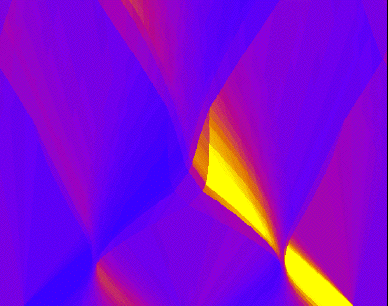A Matlab code for front tracking
This site will look much better in a browser that supports web standards. Your browser does not support web standards, use pgDown/pgUp to navigate.
You can download all files mentioned below by clicking on MatlabCode.zip
The front-tracking code described in the book resides in several files
containing many Matlab routines. These routines perform the bookeeping
needed to do the tracking. In other words, the fronts and the collision
times are recorded, and the approximate Riemann solver is called, and
the result inserted in the correct place. The routine that does this is
called genFrontTrac and resides in the file genFrontTrack.m.
The syntax for using this function is
[u,x]=genFrontTrack(u0,x0,T,delta,varargin);
Here u0 is a vector containing the initial values as a step function,
of size [nc,N], where nc is the number of components,
and N is the number of values. The "steps" are
located at x0, which is a vector of size N-1.
The variable T denotes the time at which the solution is
wanted, delta is the parameter giving the accuracy of the
approximate Riemann solver. The parameter varargin may contain
various options, typically a codeword possibly followed by a value for
that option. These must be:
Warning: If you use a very small
'display':followed by either'lines'; for drawing the fronts as lines, or'polygons';for drawing colored polygons, or'plain';forno graphical output (default).
'save',which creates Matlab graphics that can be saved from Matlab, default not, this uses a lot of Matlab's memory. This has no value, i.e., must not be followed by any option.
'colors'must be followed by a Matlab colormap to be used for colored polygons. This option has no effect if the'polygons'option is not used. The default colormap isjet.
'periodic'if periodic boundary conditions is used. This option must be followed by an interval[a,b], wherea<x0(1)<x0(N-1)<b. Also the equalityu0(:,1)=u0(:,length(u0))must hold in this case.
delta,
or there are many fronts, it may happen that genFrontTrack
terminates with the error message: "not increasing t_coll".
This means that it finds a collision time that is smaller then the "present".
Of course, this would wreck the structure of the interactions, and it is
perhaps better to stop. The reason for this is that at some point, the collision
times have not been sufficiently accurately calculated, see collision_time,
below.
Routines used by genFrontTrack
Apart from the approximate Riemann solver (we return to this below) genFrontTrack
uses several utility routines.
initialize(u0,x0,T,delta)This routine creates the initial fronts by solving the Riemann problems defined byu0andx0. It returns[u,s,t_coll,x], whereuis the values of the step function approximation to the solution of the Riemann problems,sare the speeds of the fronts,xare the starting points of the fronts, (so the actual position will by given byx(t)=x+s*t), andt_collis the collision times. The collision times are associated with an interval, therefore this is a vector of the same length asu, whilesis associated with the fronts, and therefore these are of the same length. Note that if the length ofuisM, then the length ofxisM-1. This routine is in the fileinitialize.m.
collision_time(s,t,x,T)This routine calculates the collision time between two fronts. Heres=[s(1) s(2)],t=[t(1),t(2)],x=[x(1),x(2)]andTis the final time. Here the left (right) front has speeds(1)(s(2)), starting timet(1)(t(2)), and starting pointx(1)(x(2)). This routine is in the filecollision_time.m.Graphical routines
Some routines are needed to produce the colored polygons. First there is the routine
colfunc(u). This function determines which quantity, i.e., a function ofu, that determine the color of the output. The relevant file iscolfunc.m. To actually plot a color, we need an index into the colormap, the routine that gives this isclindex(u,pmax,pmin,NMAP).Herepmaxandpmingive the interval ofcolfunc's that are plotted. Ifugives a value that is outside this interval, the appropriate endpoint is used.NMAPis the lenght of the colormap, i.e., the colormap is a matrix of size[NMAP,3].clindexis found inclindex.m.
The approximate Riemann solver
The most important routine in genFrontTrack is the Riemann
solver. Herein resides all the physics & mathematics. The syntax for
calling this is
[u,s]=Riemannsol(ul,ur,delta);
Here ul and ur are the left and right states,
and delta controls the accuracy of the solution. The output
is the speeds of the fronts resulting from the approximate solution; s,
which is a vector of size ns, and the intermediate
states u, is a vector of size [nc,ns-1].
Thus, if there is only one front, i.e., ns=1, then u=[]!
Demonstration solver
You are of course supposed to write your own Riemann solver to suit your
own needs, but for demonstration purposes we have supplied a Riemann solver
for the p-system of gas dynamics, for a gamma gas law with gamma=1. The
calculation is done in Riemann coordinates, so in order to obtain the
physical variables p (density) and v (velocity) you use the routines [p,v]=Riemann_to_Phys(w)
and its inverse w=Phys_to_Riemann(p,v).
The advantage of using Riemann coordinates is that the rarefaction
curves are straight lines, and thus easy to compute. This Riemann solver
is in the file Riemannsol.m,
(which you should replace by your own if you wish to solve other problems).
This needs the routines middle_state.m,
Jack.m, dJack.m,
states.m, sspeed.m,
phi.m, dphi.m
and rspeed.m.
Demonstration file
To test all this you can try to run the Matlab script ftdemo.m.
This needs the utility plotFTresult.m.
If you try this without any changes, you should get something like

Try out the other options, change the size of N and try other initial data, try without periodic boundary conditions, and try changing the colors. Then you are ready to write your own Riemann solver for your own problems!
Happy tracking !
